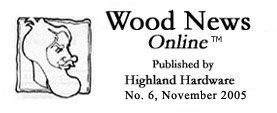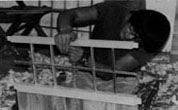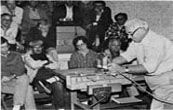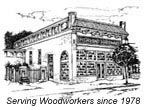|
|
 Touching
Up Repairs and Defects
Touching
Up Repairs and Defects
by Alan Noel
Every so often we all have the problem of
having to putty a nail hole, dent or gouge in the project we are
working on. We soon discover during the finishing process that these
repairs, along with those pesky glue spots that get missed during
the sanding process, stick out like a sore thumb...and I've had
my fair share of these, both literally and figuratively!
Get in Touch with Your Inner Artist
Ways to hide these and other defects are to
touch them up with a small artist's brush and
Behlen Furniture Powders
(dry pigment touch-up powders) to blend together the patch and surrounding
areas before finishing. Or, if the holes are small enough, a
wax
stick
of the appropriate color will do the job.
When using the powders I start with the following: burnt and raw
umber, burnt and raw sienna, medium yellow, white and black. Using
these earth tones in different combinations and very thin shellac
as a binder, with a little experimentation the artist hidden in
all of us can usually figure out how to match most common cabinet
woods if a natural finish is being applied or the wood is being
stained.
Be sure to practice first on a piece of scrap wood. It's important
to treat the scrap in the same way as the piece you're working on,
such as sanding and staining it the same and yes, glue spots count
too!
Seeing the Light
Working in the proper lighting is a must when
repairing or touching up a piece of furniture. The color match has
to be as close as possible to make the repair blend in. In my experience
the only way to be sure that you are on the right path is to work
only in natural or incandescent light. Fluorescent lights are what
we know as cool white, and unlike natural or "burning light" which
allow for the total spectrum, these seem to cast a bluish tint on
what we see and tend to kill the reds at the same time. Trying to
make a color match under these conditions is futile.
In my shop I have an old lamp that I use when a perfect match has
to be achieved. I will turn off all of the lights in the shop and
only have the lamp on, so the lighting will be the same as what we
have in our homes or, if the piece will be used in a very bright room
that has a lot of glass, I will take it next to a window or outdoors
for the color match.
Patience is a Virtue
In the appropriate lighting, mix the powders
with very thin
shellac
or
Behlen Qualasole
and begin by matching the lightest color or
"background" color first. Seal this layer and each successive layer
of the mixed powders down with a very light coat of
spray lacquer
,
because the true color is only visible with some type of finish over
it. You will see that as the powders dry they become hazy and appear
lighter. Be sure to let each coat of the lacquer dry thoroughly before
moving on to the next layer, if one is necessary. When you are done,
stand back 6 feet and survey your work; if you can't see it, no one
else will either.
Since the binder is shellac and the colors have been "locked down"
with spray lacquer, brushing a coat of varnish, shellac or spraying
the piece with lacquer will not disturb the touch-up.
Tips to remember:
-
Only mix colors and do touch-ups in natural
or incandescent light.
-
Always start with the lightest color first
then move on to darker colors, such as those in knots or grain
lines. Going from light to dark is much easier than going from
dark to light.
-
Seal the first and each successive layer with
a light coat of spray lacquer, and be sure to let dry thoroughly
between each coat.
-
Practice on scraps before using these techniques
on your work!
|
|




